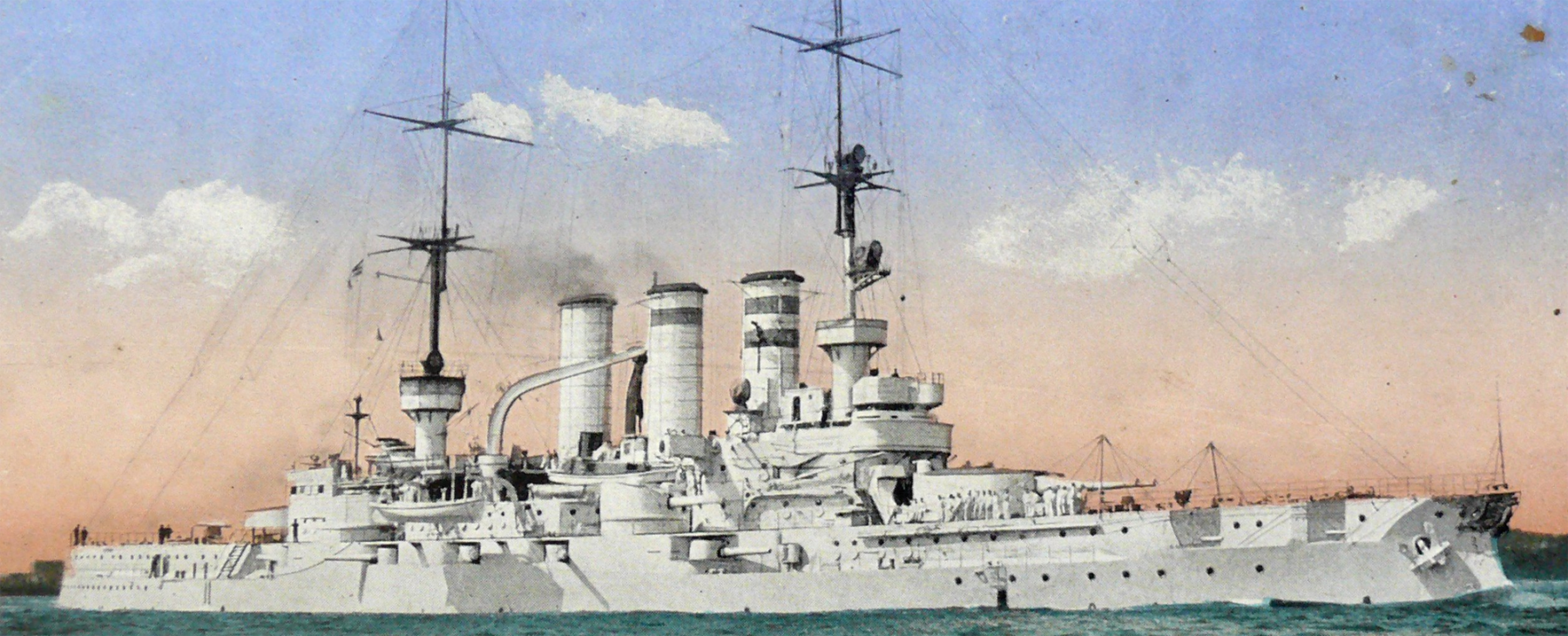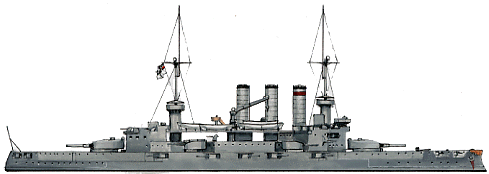Braunschweig class battleships (1902)
 Germany (1906)
Germany (1906)
Battleships Braunschweig, Elsass, Hessen, Prussen, Lothringen
Improved pre-dreadnoughts with three funnels
The Braunschchweig were another group of five German pre-dreadnought battleships ordered as part of Tirpitz 1898 naval law. After the Kaisers and Wittlesbach, they proceeded in a straightforward fashion, improving all what they could compared to the previous design; In protection, speed, and armament, with secondary barbettes with 170 mm guns instead of 140, giving them much appreciated punch and range over standard 6-in guns used by the Royal Navy. Much like the other classes they remained mostly inactive during WW1and were eventually disarmed between 1916 and 1917, their guns recycled onto railways and being converted to minor duties, training or depot ships, surviving into the 1930s.
Improved Battleships with a powerful secondary battery
The Braunschweig class were essentially heavier versions of the previous Wittelsbach, but with a more powerful armament, 280 mm instead of 240 mm for the main battery and for the secondary battery 170 mm instead of 150 mm. The idea was to compensate for the lighter caliber of the main artillery with a secondary one that can engage the enemy at an intermediary range, pummelling the superstructures. In any case it was a true leap forward and gradually closing to the British classes.
Design of the Braunschweig
This class of 5 battleships (second set of “regions”) included the Braunschweig, Elsass, Hessen, Preussen, and Lothringen. They were started in 1901-1902 in Schichau, Germaniawerft and Vulcan. Elsass and Lothringen carried a significant weight for the French, since they were German translation of former French border regions “Alsace” and “Lorraine” obtained after the war of 1870 and a constant hot point behind French motivations to war and revenge over Germany.
Armament
They drifted closely from the previous Wittlesbach, but their secondary artillery, partly in barbettes and partly in simple turrets, was changed to 170 mm caliber, which was unique at the time, and included some of the weakness of the 280 mm in range and to penetrating power lower than English 12-inch pieces.
Propulsion
They had a new boiler system, with the power and speed increasing, and this time they had three fireplaces. They reached 25.6 meters wide, and in fact remained fairly stable. Their front turret was returned to normal position.
Armor
As said above the Braunschweig drifted closely from the previous Wittlesbachs, but with a more potent main artillery, and a powerful secondary one partly in barbettes and partly in simple turrets, 170 mm caliber, quite unique at the time. This somewhat compensated for the weakness of the 280 mm in range and to penetrating power, always lower than the British 12-inch pieces.
Active service
By far the heaviest German pre-dreadnoughts, they remained relatively inactive at the beginning of the war. They formed the 4th squadron based in the Baltic and intended for the possible exits of the Russian fleet. Because of the lack of crews, they were partially put in reserve, being officially ranked as coastguard. In 1916, their secondary battery was removed and they kept only a few pieces of 88 mm.
In 1919, Preussen and Lothringen were converted into type F star-holders. The experiment was interrupted in 1938, and the Preussen was broken up, as were the other units of the class in 1931. Hessen, on the other hand, was radio-controlled target ship, survived the Second World War and was awarded war damage to the USSR in 1946 renamed Tsel.
Links/read more
en.wikipedia.org/wiki/Braunchsweig-class_battleship
https://www.fr.naval-encyclopedia.com/
https://www.naval-encyclopedia.com/ww1/pages/hochseeflotte/hochseeflotte.htm
https://www.kaiserliche-marine.de
https://www.sms-navy.com/
Specs Conway’s all the world fighting ships 1860-1905, 1906-1921.
Braunschweig specifications |
|
| Dimensions | 127,7 x 25,6 x 8.1 m |
| Displacement | 14 167 t FL |
| Crew | 743 |
| Propulsion | 3 shafts, 3 TE engines, 12 boilers, 17 000 hp |
| Speed | 18.5 knots ( km/h; mph) |
| Range | 5,000 nautical miles (9,300 km; 5,800 mi) @10 knots |
| Armament | 4 x 280mm (2×2), 18 x 170mm, 12 x 88 mm, 6 x 450 mm TTs |
| Armor | Belt 150mm, deck 65mm, CT 150mm, turrets 250mm |
Author’s rendition of the Braunschweig class



 Latest Facebook Entry -
Latest Facebook Entry -  X(Tweeter) Naval Encyclopedia's deck archive
X(Tweeter) Naval Encyclopedia's deck archive Instagram (@navalencyc)
Instagram (@navalencyc)





 French Navy
French Navy Royal Navy
Royal Navy Russian Navy
Russian Navy Armada Espanola
Armada Espanola Austrian Navy
Austrian Navy K.u.K. Kriegsmarine
K.u.K. Kriegsmarine Dansk Marine
Dansk Marine Nautiko Hellenon
Nautiko Hellenon Koninklije Marine 1870
Koninklije Marine 1870 Marinha do Brasil
Marinha do Brasil Osmanlı Donanması
Osmanlı Donanması Marina Do Peru
Marina Do Peru Marinha do Portugal
Marinha do Portugal Regia Marina 1870
Regia Marina 1870 Nihhon Kaigun 1870
Nihhon Kaigun 1870 Preußische Marine 1870
Preußische Marine 1870 Russkiy Flot 1870
Russkiy Flot 1870 Svenska marinen
Svenska marinen Søværnet
Søværnet Union Navy
Union Navy Confederate Navy
Confederate Navy Armada de Argentina
Armada de Argentina Imperial Chinese Navy
Imperial Chinese Navy Marinha do Portugal
Marinha do Portugal Mexico
Mexico Kaiserliche Marine
Kaiserliche Marine 1898 US Navy
1898 US Navy Sovietskiy Flot
Sovietskiy Flot Royal Canadian Navy
Royal Canadian Navy Royal Australian Navy
Royal Australian Navy RNZN Fleet
RNZN Fleet Chinese Navy 1937
Chinese Navy 1937 Kriegsmarine
Kriegsmarine Chilean Navy
Chilean Navy Danish Navy
Danish Navy Finnish Navy
Finnish Navy Hellenic Navy
Hellenic Navy Polish Navy
Polish Navy Romanian Navy
Romanian Navy Turkish Navy
Turkish Navy Royal Yugoslav Navy
Royal Yugoslav Navy Royal Thai Navy
Royal Thai Navy Minor Navies
Minor Navies Albania
Albania Austria
Austria Belgium
Belgium Columbia
Columbia Costa Rica
Costa Rica Cuba
Cuba Czechoslovakia
Czechoslovakia Dominican Republic
Dominican Republic Haiti
Haiti Hungary
Hungary Honduras
Honduras Estonia
Estonia Iceland
Iceland Eire
Eire Equador
Equador Iran
Iran Iraq
Iraq Latvia
Latvia Liberia
Liberia Lithuania
Lithuania Mandchukuo
Mandchukuo Morocco
Morocco Nicaragua
Nicaragua Persia
Persia San Salvador
San Salvador Sarawak
Sarawak Uruguay
Uruguay Venezuela
Venezuela Zanzibar
Zanzibar Warsaw Pact Navies
Warsaw Pact Navies Bulgaria
Bulgaria Hungary
Hungary

 Bundesmarine
Bundesmarine Dutch Navy
Dutch Navy Hellenic Navy
Hellenic Navy Marina Militare
Marina Militare Yugoslav Navy
Yugoslav Navy Chinese Navy
Chinese Navy Indian Navy
Indian Navy Indonesian Navy
Indonesian Navy JMSDF
JMSDF North Korean Navy
North Korean Navy Pakistani Navy
Pakistani Navy Philippines Navy
Philippines Navy ROKN
ROKN Rep. of Singapore Navy
Rep. of Singapore Navy Taiwanese Navy
Taiwanese Navy IDF Navy
IDF Navy Saudi Navy
Saudi Navy Royal New Zealand Navy
Royal New Zealand Navy Egyptian Navy
Egyptian Navy South African Navy
South African Navy






























 Ukrainian Navy
Ukrainian Navy dbodesign
dbodesign